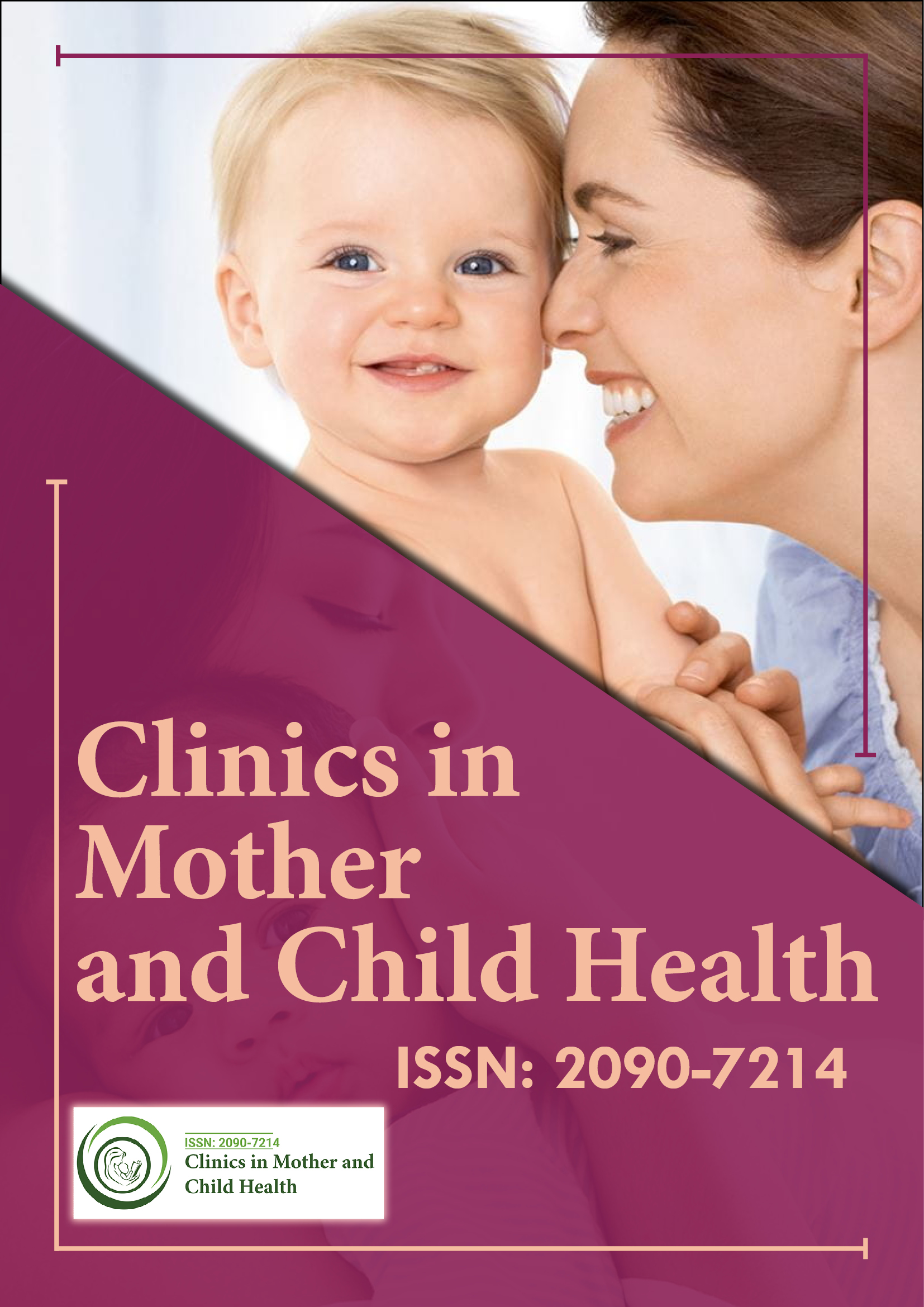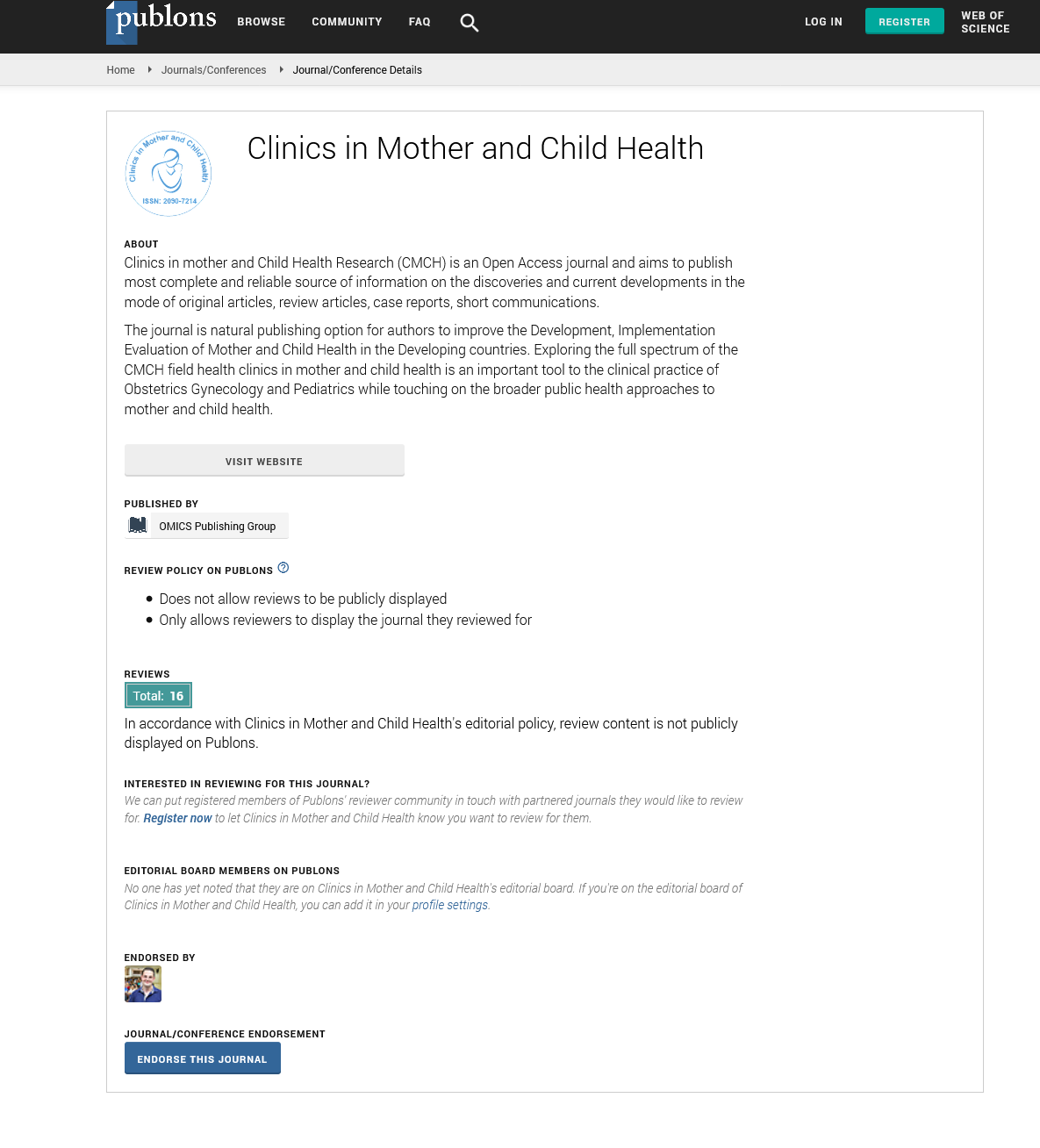Indexed In
- Genamics JournalSeek
- RefSeek
- Hamdard University
- EBSCO A-Z
- Publons
- Geneva Foundation for Medical Education and Research
- Euro Pub
- Google Scholar
Useful Links
Share This Page
Journal Flyer

Open Access Journals
- Agri and Aquaculture
- Biochemistry
- Bioinformatics & Systems Biology
- Business & Management
- Chemistry
- Clinical Sciences
- Engineering
- Food & Nutrition
- General Science
- Genetics & Molecular Biology
- Immunology & Microbiology
- Medical Sciences
- Neuroscience & Psychology
- Nursing & Health Care
- Pharmaceutical Sciences
Perspective - (2025) Volume 22, Issue 2
Evaluating the Role of Mobile Health (mHealth) Applications in Improving Antenatal Care Attendance in Underserved Regions
Entesar Jeddy*Received: 27-Jan-2025, Manuscript No. CMCH-25-28682; Editor assigned: 29-Jan-2025, Pre QC No. CMCH-25-28682; Reviewed: 12-Feb-2025, QC No. CMCH-25-28682; Revised: 18-Feb-2025, Manuscript No. CMCH-25-28682; Published: 26-Feb-2025, DOI: 10.35248/2090-7214.25.22.511
Description
Antenatal Care (ANC) is a cornerstone of maternal and neonatal health, providing essential services such as health education, nutritional support, early detection of complications and preventive interventions. However, in many underserved and remote regions, antenatal care attendance remains significantly below recommended levels due to barriers such as limited access to healthcare facilities, poor infrastructure, lack of awareness and sociocultural constraints. With the rapid expansion of mobile technology in low-resource settings, mobile health (mHealth) applications have emerged as promising tools to bridge gaps in maternal healthcare delivery. This study evaluates the effectiveness of mHealth applications in improving ANC attendance among pregnant women residing in underserved regions, focusing on both the reach and the behavioral impact of these digital interventions.
The research was conducted as a multicenter cross-sectional study in three geographically and culturally diverse underserved regions, encompassing both rural and peri-urban populations. A total of 1,200 pregnant women were enrolled, divided equally between intervention and control groups. The intervention group received access to a locally customized mHealth application designed to deliver health reminders, educational content, appointment scheduling and two-way communication with community health workers. The control group received standard care without access to the mHealth platform. Participants were followed from early pregnancy (before 16 weeks gestation) until delivery, with data collected on ANC visit adherence, gestational age at first visit, knowledge about antenatal care and user satisfaction.
The results revealed a marked improvement in antenatal care attendance among women using the mHealth application. In the intervention group, 78% of participants completed at least four ANC visits, compared to 52% in the control group. Furthermore, the average gestational age at first ANC visit was earlier in the intervention group (13.2 weeks) than in the control group (17.5 weeks), indicating that the mHealth intervention was effective in promoting timely care-seeking behavior. The application’s reminder feature, which included SMS alerts and in-app notifications, played a pivotal role in improving adherence by reinforcing the importance of regular checkups and helping users plan their visits in advance.
In-depth interviews and focus group discussions with participants revealed that the availability of accurate and localized health information increased women’s awareness of danger signs, proper nutrition and birth preparedness. Many women reported that the app empowered them to make informed decisions and gave them the confidence to seek care independently, especially in cases where male family members were not supportive. The option to consult health workers via chat or voice call provided an added layer of reassurance, reducing anxiety and encouraging continued engagement with healthcare services.
The study also highlighted the importance of cultural and contextual relevance in mHealth application design. The intervention app was developed with input from local stakeholders, including midwives, community health volunteers and pregnant women, to ensure that the language, imagery and content were culturally appropriate and easy to understand. This participatory approach contributed significantly to user acceptability and engagement. Digital literacy support was provided during the onboarding phase to help first-time smartphone users navigate the application, which proved crucial for successful adoption in low-literacy settings.
In addition to individual-level improvements, the mHealth platform facilitated better communication and coordination among healthcare providers. Community health workers could track patient progress, identify defaulters and intervene promptly when followup was needed. The backend data collected through the application enabled healthcare administrators to monitor ANC service delivery patterns and identify geographic or systemic gaps in real time. This data-driven approach contributed to more responsive healthcare planning and resource allocation in the participating regions.
Despite the promising results, the study also identified challenges that could limit the scalability and long-term sustainability of mHealth solutions in underserved regions. These included intermittent electricity supply, mobile network disruptions and the cost of smartphones and internet access for some users. Moreover, while digital interventions showed strong results in improving attendance, they did not entirely address deeper systemic issues such as transport barriers, understaffed health centers and entrenched gender norms. Therefore, mHealth should be viewed as a complementary tool rather than a standalone solution, best used in conjunction with broader health system strengthening efforts. This study provides compelling evidence that mobile health applications can significantly enhance antenatal care attendance and engagement in underserved regions. By combining accessible technology with culturally tailored health education and communication features, mHealth interventions can empower pregnant women, improve maternal health behaviors and support frontline health workers. As digital technology becomes increasingly ubiquitous, integrating mHealth into national maternal health strategies has the potential to transform healthcare delivery and promote equity in maternal outcomes. Future efforts should focus on improving infrastructure, digital inclusivity and multisectoral collaboration to ensure the long-term impact and sustainability of these interventions.
Citation: Jeddy E (2025). Evaluating the Role of Mobile Health (mHealth) Applications in Improving Antenatal Care Attendance in Underserved Regions. Clinics Mother Child Health. 22:511.
Copyright: © 2025 Jeddy E. This is an open-access article distributed under the terms of the Creative Commons Attribution License, which permits unrestricted use, distribution and reproduction in any medium, provided the original author and source are credited.

